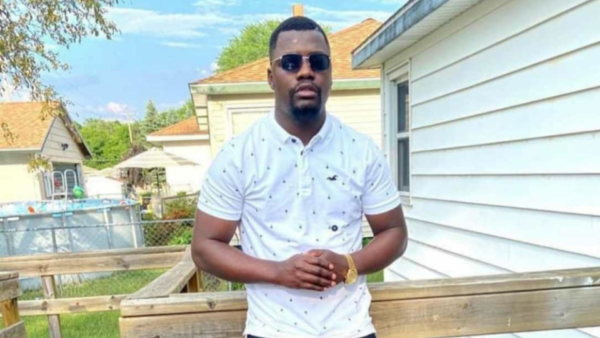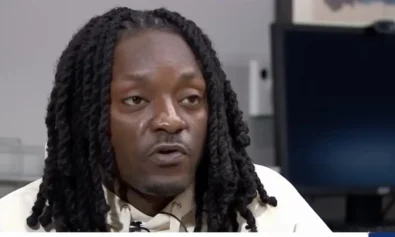The Grand Rapids Police Department has released the video of one of its officers shooting an unarmed Black man in Michigan after he was stopped for having a bad license plate on his car.
The graphic footage reignites the argument about how quick cops are to use excessive force that results in death when engaging with Black people deemed resistant versus how hesitant they are when engaging such whites.

The force released four of nine videos capturing different angles and perspectives of Patrick Lyoya’s April 4 killing during a press conference on Wednesday, April 13. GRPD Chief Eric Winstrom, who has been on the job for a little over 30 days, went against Kent County prosecutors by making the footage public, hoping to show transparency to a community outraged by Lyoya’s death.
One clip is from the patrol car’s dashcam video. The officer’s bodycam was also released, alongside the cellphone video from a witness who was in the car with the 26-year-old and emerged from the vehicle once the arrest became violently physical. The last video was from a surveillance camera from a house in proximity to the crime scene.
The surveillance video from home they were in front of, records the officer yelling for Lyoya to let go of his taser. Police say, and it is heard in a few of the videos, the taser was dispatched twice, both times hitting the ground.
In the witness’ video, the officer is seen on top of Lyoya, forcefully pinning him down, as the man struggled beneath him. The two are upright, but Lyoya is clearly restrained by the officer, who says, “Stop resisting.”
The witness shouts at him, “He’s not resisting.” As he shouts over and over again, “let go of my taser,” the witness says, “He doesn’t have the taser.”
Seconds later, the officer pulls his gun out and while hovering over him with his body facing the ground, shoots Lyoya in the back of his head with his firearm.
He gets up and backs away, does not render aid, and calls to report the shooting.
Facts that are not up for dispute are as follows: (1) a yet-to-be-identified officer engaged the Congolese immigrant about his car’s license plate, (2) when being detained, the man attempted to flee, ending in the officer wrestling him down to the ground, tasing him and shooting him point-blank in his head, and (3) the footage from the officer’s bodycam went dead right before the fatal shot.
Issues surrounding how the bodycam was disengaged have been brought up for review. ABC 13 reports even Winstrom is unclear about how it fell off of the officer.
Another issue is the idea of resisting arrest. Lyoya does run from the officer, but this is after calmly speaking to him and then being grabbed to be handcuffed.
An online debate erupted soon after the cellphone footage was posted to Twitter. Many said the officer didn’t have a choice, while others offered video example of how this plays out with a white person. One video retweeted was by ESPN sports commentator Shannon Sharpe in August 2020 of a trucker cussing an officer out and threatening to kill him for asking for his ID.
The former NFL player says, “Is this noncompliance? We were told, noncompliance is a death sentence. I need an explanation.”
Professor Seth Stoughton, the excessive force expert from the Derek Chauvin murder case, addressed Lyoya’s initial “resisting” of arrest. He told local station Target 8 the first mistake the officer made was to chase the unarmed suspect, without cover from an occupying officer.
“If one person in a car goes running away, the officer just kind of watches and waves goodbye, while they deal with the people in the car. Safety should always be a priority,” Stoughton said.
He also talked about how the officer tried to detain Lyoya, “The officer just does not look like he knows how to take this person into custody.”
“You have the Taser so you can create safe distance and deploy the Taser to do what it is supposed to do,” Ben Crump, the family’s lawyer, said. “But when you are in close proximity, you are not following the basic training of Taser use.”
According to Crump, it was a natural reaction for his client’s son to reach to push the Taser away.
“And the officer deployed his Taser twice, and that model of Taser only allows you to fire it twice. And once … you fired it twice, and this is important, unless you have another cartridge to put in the Taser … it is ineffective,” Crump assessed. “So, there’s no reason for him to have any intimate fear of the Taser being used against him.”
“[The officer] was on top of Patrick, and there is nothing that we have seen in that video to demonstrate that he was intimate fear for him to engage in deadly force to shoot Patrick in the back of the head,” the civil rights attorney continued.
Another lawyer, Ven Johnson pointed to audio of multiple videos, which present a suspect not threatening the officer with words or a weapon. Johnson said, “And I hear this everywhere, I go, ‘Yeah, but Ven, he didn’t have to fight.’ And the answer is, police are trained to engage in this very thing. That’s party of their job and training. Under the law … you cannot shoot and kill an unarmed man because he resists.”
The Boston review says police “abuse” the charge of resisting arrest when encountering Black people.
In a 2020 study, it found, “Police officers often use the charge of ‘resisting arrest’ to criminalize black people who try to defend themselves from brutal, punitive, and often illegal police actions. They also do so to justify the violence it takes to compel compliance — even if that violence results in taking a life. “
An additional concern is how quickly this traffic stop escalated into a fatality. One Twitter user wrote, “When was the motto ‘To protect and serve’ replaced with ‘Judge, jury and executioner’?”
Too often, studies show, the motto changes based on race. The Lancet released a report titled “Fatal Police Violence by Race and State in America” in October 2021, called the use of excessive force while policing people of color “systemic” and “an urgent public health crisis” for the nation.
In the Lyoya case, the Michigan State Police, who took over the investigation, nor GRPD are clear on the officer’s decision-making because he has not been interviewed about the killing.
The officer, who is on administrative leave, is required to give a written statement to his own department about firing his gun in the course of duty, but such a statement would not be used in the criminal investigation against him.
For some in the community, it appears law enforcement is not only taking its time to question the shooter but is protecting him by hiding his name.
“Isn’t it interesting how they protect the identities of police officers who murder people in broad daylight but blast everyone else’s mugshot all over the media? They have yet to name the officer who killed Tony McDade and now they’re doing the same to Patrick Lyoya,” one person tweeted.
Winstrom is promising transparency as he notes that the investigation is still in its early stages,
“We have an outside agency looking into this incident. It’s the Michigan State Police. Generally speaking, when they complete their investigation is traditionally when videos like this would be released,” Winstrom said.
“We felt that on balance it was more important to be transparent with the community to provide what information the Grand Rapids Police Department has immediately before that process is finished.”
Crump says, “The video clearly shows that this was an unnecessary, excessive, and fatal use of force against an unarmed Black man who was confused by the encounter and terrified for his life.”
“It should be noted that Patrick never used violence against this officer even though the officer used violence against him in several instances for what was a misdemeanor traffic stop.”
The family has not seen Lyoya’s body yet. It is being held at the county medical examiner office, until the family makes arrangements. Their lawyer suggests this may happen on Friday, Apr. 15.


